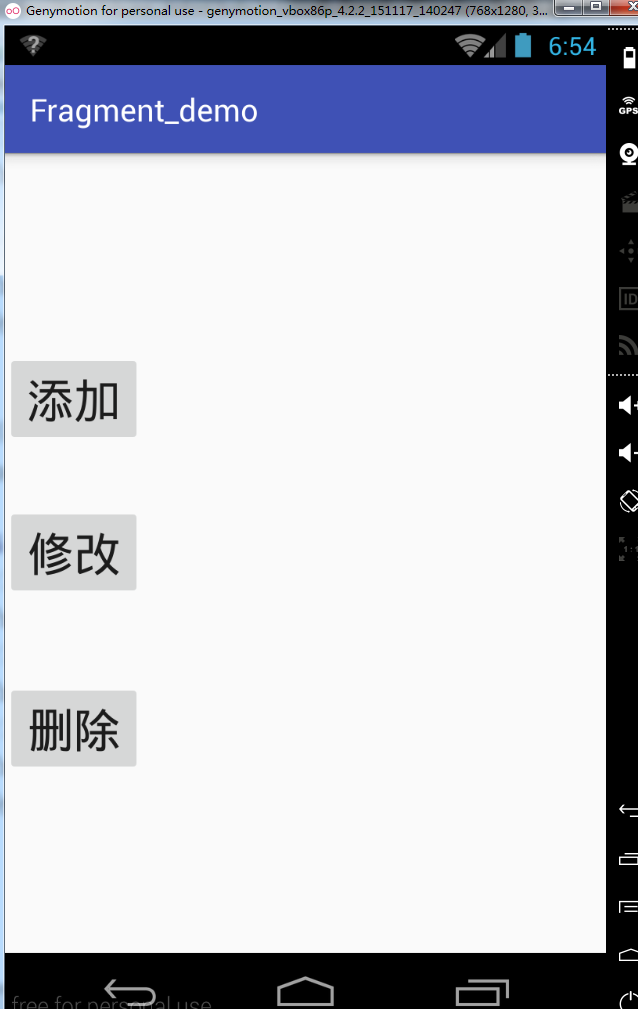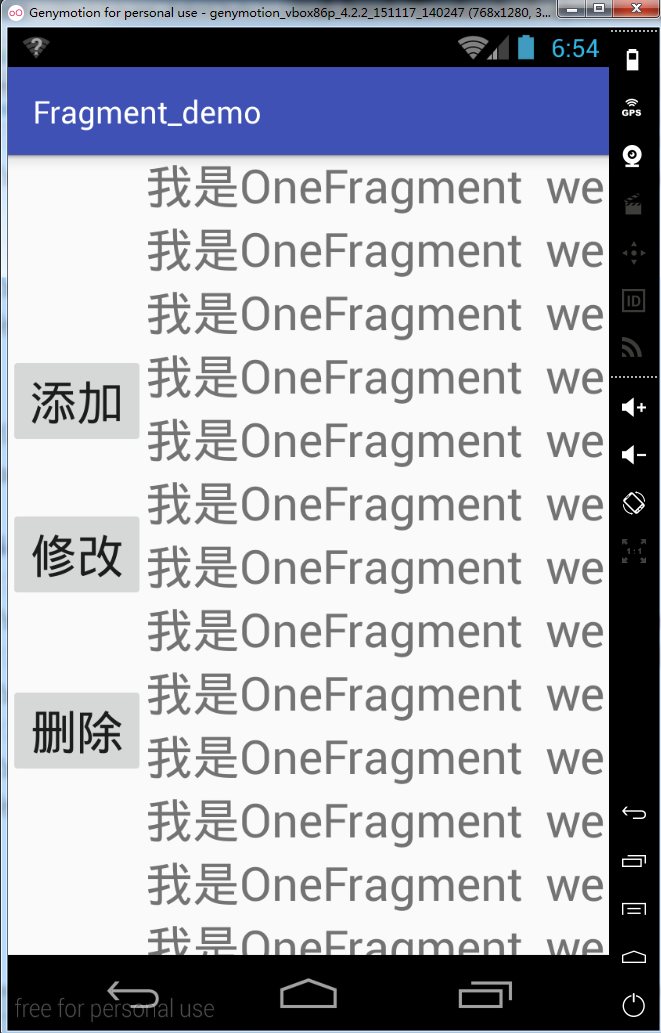友情链接:点击打开链接
1.将Activity传值到Fragment
具体步骤:
<1>声明碎片事务器对象
private FragmentManager fragmentManager;
<2>得到碎片事务器对象
FragmentTransaction fragmentTransaction = this.FragmentManager.beginTransaction();
<3>将我们需要添加的Fragment对象作为子元素添加到LinearLayout的Container容器中
fragmentTransaction.add(R.id.linearLayout_container,Fragment);
<4>将之前添加的Fragment对象也向Fragment的返回栈添加一份
fragmentTransaction.addBackStack(null);
<5>提交碎片事务,提交之后的操作才会生效。
fragmentTransaction.commit();
具体效果:
实例代码:
业务逻辑代码:
package com.example.tf.fragment_demo;
import android.app.FragmentManager;
import android.app.FragmentTransaction;
import android.os.Bundle;
import android.support.v7.app.AppCompatActivity;
import android.view.View;
import com.example.tf.fragment_demo.fragments.OneFragment;
import com.example.tf.fragment_demo.fragments.TwoFragment;
public class MainActivity extends AppCompatActivity {
/**
* 声明碎片管理器对象
*/
private FragmentManager fragmentManager;
@Override
protected void onCreate(Bundle savedInstanceState) {
super.onCreate(savedInstanceState);
setContentView(R.layout.activity_main);
//1.得到碎片管理器对象
this.fragmentManager=this.getFragmentManager();
}
//private OneFragment oneFragment=new OneFragment();//多次添加同一个地址报错
private OneFragment oneFragment;
/**
* 添加Fragment
* 注意:同一个fragment对象只能往同一个容器中添加一次,如果多次添加会报异常:java.lang.IllegalStateException: Fragment already added: OneFragment{5352c090 #0 id=0x7f0c0053}
* @param view
*/
public void add(View view){
oneFragment=new OneFragment();
//2.通过碎片管理器对象得到碎片事务对象
FragmentTransaction fragmentTransaction=this.fragmentManager.beginTransaction();
//将oneFragment对象作为linearLayout_container的子元素添加到linearLayout_container容器里面
fragmentTransaction.add(R.id.linearLayout_container,oneFragment);
//将之前添加到容器linearLayout_container里面的fragment 也添加到fragment 返回栈中一份
fragmentTransaction.addToBackStack(null);
//提交碎片事务,提交之后之前的操作才会生效
fragmentTransaction.commit();
System.out.println("===add=====");
}
private TwoFragment twoFragment;
/**
* 修改Fragment
* @param view
*/
public void update(View view){
//2.通过碎片管理器对象得到碎片事务对象
FragmentTransaction fragmentTransaction=this.fragmentManager.beginTransaction();
twoFragment=new TwoFragment();
//使用TwoFragment 替换LinearLayout 容器中的其它子元素,如果之前添加了多个子元素,则只替换其中部分子元素
//replace 在替换指定Fragment 对象时会首先判断LinearLayout容器中是否有子元素,如果没有则直接添加一个子元素
fragmentTransaction.replace(R.id.linearLayout_container,twoFragment);
//提交碎片事务,提交之后之前的操作才会生效
fragmentTransaction.commit();
System.out.println("===update=====");
}
/**
* 删除Fragment
* @param view
*/
public void delete(View view){
//2.通过碎片管理器对象得到碎片事务对象
FragmentTransaction fragmentTransaction=this.fragmentManager.beginTransaction();
//将twoFragment对象从碎片事务管理器中删除,即从指定容器中删除了
fragmentTransaction.remove(twoFragment);
//提交碎片事务,提交之后之前的操作才会生效
fragmentTransaction.commit();
System.out.println("===delete=====");
}
}
主UI视图的xml代码:
<?xml version="1.0" encoding="utf-8"?>
<RelativeLayout xmlns:android="http://schemas.android.com/apk/res/android"
android:layout_width="match_parent"
android:layout_height="match_parent">
<Button
android:layout_width="wrap_content"
android:layout_height="wrap_content"
android:text="添加"
android:onClick="add"
android:textSize="30sp"
android:id="@+id/button_add"
android:layout_alignParentTop="true"
android:layout_alignParentStart="true"
android:layout_marginTop="127dp" />
<Button
android:layout_width="wrap_content"
android:layout_height="wrap_content"
android:text="修改"
android:onClick="update"
android:textSize="30sp"
android:id="@+id/button_update"
android:layout_centerVertical="true"
android:layout_alignParentStart="true" />
<Button
android:layout_width="wrap_content"
android:layout_height="wrap_content"
android:text="删除"
android:onClick="delete"
android:textSize="30sp"
android:id="@+id/button_delete"
android:layout_marginTop="52dp"
android:layout_below="@+id/button_update"
android:layout_alignParentStart="true" />
<!--
如果想同时实现水平和垂直两个方向的滚动操作,则可以使用ScrollView 嵌套HorizontalScrollView或者
HorizontalScrollView嵌套ScrollView都可以实现水平和垂直两个方向的滚动操作
-->
<ScrollView
android:layout_width="match_parent"
android:layout_height="match_parent"
android:layout_toEndOf="@+id/button_add">
<HorizontalScrollView
android:layout_width="match_parent"
android:layout_height="match_parent"
android:layout_toEndOf="@+id/button_add">
<LinearLayout
android:id="@+id/linearLayout_container"
android:orientation="vertical"
android:layout_width="match_parent"
android:layout_height="match_parent"
android:layout_alignParentTop="true"
android:layout_toEndOf="@+id/button_add">
</LinearLayout>
</HorizontalScrollView>
</ScrollView>
</RelativeLayout>
<1>第一个Fragment.java
package com.example.tf.fragment_demo.fragments;
import android.app.Fragment;
import android.os.Bundle;
import android.support.annotation.Nullable;
import android.view.LayoutInflater;
import android.view.View;
import android.view.ViewGroup;
import com.example.tf.fragment_demo.R;
import java.util.zip.Inflater;
/**
* Created by TF on 2018/6/13.
*/
public class OneFragment extends Fragment {
@Nullable
@Override
public View onCreateView(LayoutInflater inflater, ViewGroup container, Bundle savedInstanceState) {
return inflater.inflate(R.layout.fragment_one,null);
}
}
<2>第二个Fragment.java
同上,基本没有区别
[1]第一个的xml布局代码:
<?xml version="1.0" encoding="utf-8"?>
<LinearLayout xmlns:android="http://schemas.android.com/apk/res/android"
android:orientation="vertical" android:layout_width="match_parent"
android:layout_height="match_parent">
<TextView
android:layout_width="match_parent"
android:layout_height="wrap_content"
android:text="我是OneFragment we help each other and we love each other love me love my dog"
android:singleLine="true"
android:gravity="center"
android:textSize="30sp"
android:id="@+id/textView_one" />
</LinearLayout>
[2]第二个的xml布局代码:
同上,与第一个没有区别
2.将Fragment传值给Activity
1.得到Fragment所依附的Activity并通过findViewById()查找控件并赋值。
2.通过得到fragment所依附的Activity并给Activity提供setter函数传值到Activity或者让Activity实现传值的
接口来实现。
实例效果:
业务逻辑代码:
主类代码:
package com.example.lenovo.dialog_demo;
import android.content.DialogInterface;
import android.preference.DialogPreference;
import android.support.v7.app.AlertDialog;
import android.support.v7.app.AppCompatActivity;
import android.os.Bundle;
import android.text.TextUtils;
import android.view.View;
import android.widget.EditText;
import android.widget.TextView;
import android.widget.Toast;
import com.example.lenovo.dialog_demo.interfaces.PassValue;
import org.w3c.dom.Text;
import java.lang.reflect.Field;
public class MainActivity extends AppCompatActivity implements PassValue{
private TextView textView_name;
@Override
protected void onCreate(Bundle savedInstanceState) {
super.onCreate(savedInstanceState);
setContentView(R.layout.activity_main);
textView_name = (TextView) this.findViewById(R.id.textView_name);
}
//通过setter函数传值到当前Activity
@Override
public void setName(String name) {
textView_name.setText(name);
}
}
副类代码:
package com.example.lenovo.dialog_demo.fragments;
import android.app.Fragment;
import android.os.Bundle;
import android.text.TextUtils;
import android.view.LayoutInflater;
import android.view.View;
import android.view.ViewGroup;
import android.widget.Button;
import android.widget.EditText;
import com.example.lenovo.dialog_demo.R;
import com.example.lenovo.dialog_demo.interfaces.PassValue;
public class DetailFragment extends Fragment{
private EditText editText_userName;
@Override
public View onCreateView(LayoutInflater inflater, ViewGroup container, Bundle savedInstanceState) {
View view = inflater.inflate(R.layout.fragment_detail,container,false);
editText_userName = (EditText) view.findViewById(R.id.editText_userName);
Button button_pass = (Button) view.findViewById(R.id.button_pass);
button_pass.setOnClickListener(new View.OnClickListener() {
@Override
public void onClick(View view) {
String userName = editText_userName.getText().toString();
if(TextUtils.isEmpty(userName)){
editText_userName.setError("用户名不能为空");
editText_userName.requestFocus();
return;
}
//得到当前Fragment所依附的Activity
//MainActivity mainActivity = (MainActivity) getActivity();
//方式一:找到Activity中的TextView控件
//TextView textView_name = mainActivity.findViewById(R.id.textView_name);
//textView_name.setText(userName);
//方式二:给Activity增加setter函数传值给Activity
//mainActivity.setName(userName);
//使用接口完成通用传值操作
PassValue passValue = (PassValue) getActivity();
passValue.setName(userName);
}
});
return view;
}
}
定义一个接口:
package com.example.lenovo.dialog_demo.interfaces;
public interface PassValue {
void setName(String name);
}
用户界面的xml:
<?xml version="1.0" encoding="utf-8"?>
<LinearLayout xmlns:android="http://schemas.android.com/apk/res/android"
android:orientation="horizontal"
android:layout_width="match_parent"
android:layout_height="match_parent">
<LinearLayout
android:id="@+id/linearLayout_left"
android:orientation="vertical"
android:layout_weight="1"
android:layout_height="match_parent"
android:layout_width="match_parent"
>
<fragment
android:id="@+id/fragment"
android:layout_width="match_parent"
android:layout_height="wrap_content"
android:name="com.example.lenovo.dialog_demo.fragments.DetailFragment"
/>
</LinearLayout>
<LinearLayout
android:id="@+id/linearLayout_right"
android:orientation="vertical"
android:layout_weight="1"
android:layout_width="match_parent"
android:layout_height="match_parent"
>
<TextView
android:layout_width="match_parent"
android:layout_height="match_parent"
android:gravity="center"
android:text="姓名"
android:textSize="30sp"
android:id="@+id/textView_name"
/>
</LinearLayout>
</LinearLayout>
用户输入界面的xml:
<?xml version="1.0" encoding="utf-8"?>
<LinearLayout xmlns:android="http://schemas.android.com/apk/res/android"
android:orientation="vertical"
android:layout_width="match_parent"
android:layout_height="match_parent">
<EditText
android:layout_width="match_parent"
android:layout_height="wrap_content"
android:hint="请输入你的姓名"
android:id="@+id/editText_userName"
/>
<Button
android:layout_width="wrap_content"
android:layout_height="wrap_content"
android:text="传值到Activity"
android:id="@+id/button_pass"
/>
</LinearLayout>
3.Fragment传值给Fragment(中心思想:并不是传值,而是通过查找目标控件,将要传的值"塞"给"目标控件")。
注意:一个Fragment的子类listFragment
继承listFragment有哪些好处?
A.自带界面并且界面上有一个ListView,这个ListView对象为mList
B.点击用户界面获取数据时,监听器不用自己写,ListFragment已经封装好了,可以直接使用
主要方式:一个Fragment得到FragmentManager查找到另一个Fragment。
1.并通过setter函数查找控件并赋值。
2.getView方法得到view查找控件并赋值。
FragmentLeft(要传值的):
package com.hsj.example.fragmentpassvaluetofragmentdemo05.fragments;
import android.app.ListFragment;
import android.os.Bundle;
import android.view.View;
import android.widget.ArrayAdapter;
import android.widget.ListView;
import com.hsj.example.fragmentpassvaluetofragmentdemo05.R;
import java.util.ArrayList;
import java.util.List;
/**
* 继承ListFragment 有哪些好处?
* A:自带界面并且界面上有一个ListView,通过查看源码发现这个ListView 对象为mList
* B:点击用户条目获取数据时监听器不用自己编写,ListFragment 已经封装好了,我们直接使用
*/
public class LeftFragment_bak01 extends ListFragment {
private List<String> data;
@Override
public void onActivityCreated(Bundle savedInstanceState) {
super.onActivityCreated(savedInstanceState);
data=new ArrayList<>();
for(int i=0;i<20;i++){
data.add("小丽"+i);
}
ArrayAdapter<String> adapter=new ArrayAdapter<String>(getActivity(),android.R.layout.simple_list_item_1,data);
setListAdapter(adapter);
}
/**
* 当用户点击ListView控件上的条目时自动调用的方法
* @param l
* @param v
* @param position
* @param id
*/
@Override
public void onListItemClick(ListView l, View v, int position, long id) {
String item=data.get(position);
//由于现在LeftFragment 和RightFragment 使用的是同一个FragmentManager 添加到MainActivity 界面上的,因此可以通过FragmentManager 找到需要的Fragment
//
//TextView textView_name= (TextView) getActivity().getFragmentManager().findFragmentById(R.id.fragment_right).getView().findViewById(R.id.textView_name);
//textView_name.setText(item);
//Toast.makeText(getActivity(), "item="+item, Toast.LENGTH_SHORT).show();
RightFragment rightFragment= (RightFragment) getActivity().getFragmentManager().findFragmentById(R.id.fragment_right);
//rightFragment.setName(item);
}
}
FragmentRight(接受的):
package com.hsj.example.fragmentpassvaluetofragmentdemo05.fragments;
import android.app.Fragment;
import android.os.Bundle;
import android.support.annotation.Nullable;
import android.view.LayoutInflater;
import android.view.View;
import android.view.ViewGroup;
import android.widget.AdapterView;
import android.widget.ListView;
import android.widget.TextView;
import com.hsj.example.fragmentpassvaluetofragmentdemo05.R;
/**
* Created by hsjwcf on 2018/6/14.
*/
public class RightFragment extends Fragment {
private TextView textView_name;
@Nullable
@Override
public View onCreateView(LayoutInflater inflater, ViewGroup container, Bundle savedInstanceState) {
View view=inflater.inflate(R.layout.fragment_right,null);
textView_name= (TextView) view.findViewById(R.id.textView_name);
LeftFragment leftFragment= (LeftFragment) getActivity().getFragmentManager().findFragmentById(R.id.fragment_left);
ListView listView=leftFragment.getListView();
listView.setOnItemClickListener(new AdapterView.OnItemClickListener() {
@Override
public void onItemClick(AdapterView<?> parent, View view, int position, long id) {
//1.通过适配器控件获取数据
//String item=parent.getItemAtPosition(position).toString();
//textView_name.setText(item);
//2.通过用户点击的条目获取数据
String item=((TextView)view).getText().toString();
textView_name.setText(item);
}
});
return view;
}
}
3.注意:万能的接口回调(适合所有的处置方式):
使用步骤:
1.自定义传值的接口:
interface PassValue{
void setName(String name);
}
2.声明一个接口类型的对象:
private PassValue passvalue
3.给接口类型的对象提供setter函数:
public void setPassValue(PassValue passvalue){
this.passvalue = passvalue;
}
4.在传值的目标端(RightFragment)调用setter函数
5.在需要传值的地方调用PassValue接口类型的对象passValue.setValue(需要传递的值)
1.leftFragment:
package com.hsj.example.omnipotentinterfacecallbackdemo06.fragments;
import android.app.ListFragment;
import android.os.Bundle;
import android.view.View;
import android.widget.ArrayAdapter;
import android.widget.ListView;
import java.util.ArrayList;
import java.util.List;
/**
* 万能的接口回调的编写步骤:
* 1.自定义传值的接口
* interface PassValue{
void setName(String name);
}
2.声明一个接口类型的对象
private PassValue passValue;
3.给接口类型的对象提供setter 函数
public void setPassValue(PassValue passValue){
this.passValue=passValue;
}
4.在需要传值的目标对象中调用setter函数,相当于注册监听器对象
LeftFragment leftFragment= (LeftFragment) getActivity().getFragmentManager().findFragmentById(R.id.fragment_left);
//相当于注册监听器
leftFragment.setPassValue(new LeftFragment.PassValue() {
@Override
public void setName(String name) {
textView_name.setText(name);
}
});
5.在需要传值的地方调用传值对象的传值方法完成传值操作
passValue.setName(item);
*
*/
public class LeftFragment extends ListFragment {
private List<String> data;
//1.自定义传值的接口
interface PassValue{
void setName(String name);
}
//2.声明一个接口类型的对象
private PassValue passValue;
//3.给接口类型的对象提供setter 函数
public void setPassValue(PassValue passValue){
this.passValue=passValue;
}
@Override
public void onActivityCreated(Bundle savedInstanceState) {
super.onActivityCreated(savedInstanceState);
data=new ArrayList<>();
for(int i=0;i<20;i++){
data.add("小丽"+i);
}
ArrayAdapter<String> adapter=new ArrayAdapter<String>(getActivity(),android.R.layout.simple_list_item_1,data);
setListAdapter(adapter);
}
/*static class Add{
int add(int num1,int num2){
int sum=num1+num2;
return sum;
}
}
static class Test{
public static void main(String[] args){
Add a=new Add();
a.add(5,6);
}
}*/
@Override
public void onListItemClick(ListView l, View v, int position, long id) {
String item= data.get(position);
//执行传值操作,相当于用户点击了按钮
passValue.setName(item);
}
}
2.rightFragment:
package com.hsj.example.omnipotentinterfacecallbackdemo06.fragments;
import android.app.Fragment;
import android.os.Bundle;
import android.support.annotation.Nullable;
import android.view.LayoutInflater;
import android.view.View;
import android.view.ViewGroup;
import android.widget.TextView;
import com.hsj.example.omnipotentinterfacecallbackdemo06.R;
/**
* Created by hsjwcf on 2018/6/14.
*/
public class RightFragment extends Fragment {
private TextView textView_name;
@Nullable
@Override
public View onCreateView(LayoutInflater inflater, ViewGroup container, Bundle savedInstanceState) {
View view=inflater.inflate(R.layout.fragment_right,null);
textView_name= (TextView) view.findViewById(R.id.textView_name);
LeftFragment leftFragment= (LeftFragment) getActivity().getFragmentManager().findFragmentById(R.id.fragment_left);
//相当于注册监听器
/*leftFragment.setPassValue(new LeftFragment.PassValue() {
@Override
public void setName(String name) {
textView_name.setText(name);
}
});*/
MyPassValue myPassValue=new MyPassValue();
leftFragment.setPassValue(myPassValue);
return view;
}
class MyPassValue implements LeftFragment.PassValue{
@Override
public void setName(String name) {
textView_name.setText(name);
}
}
}


